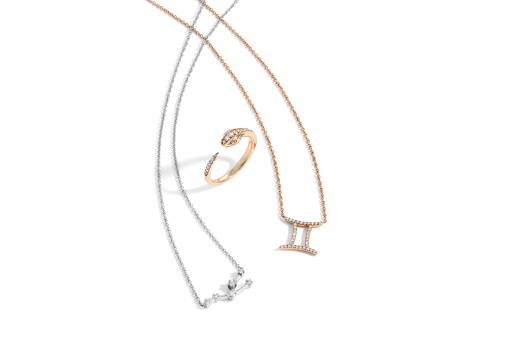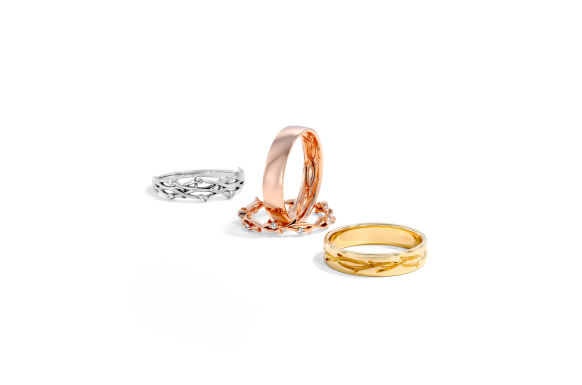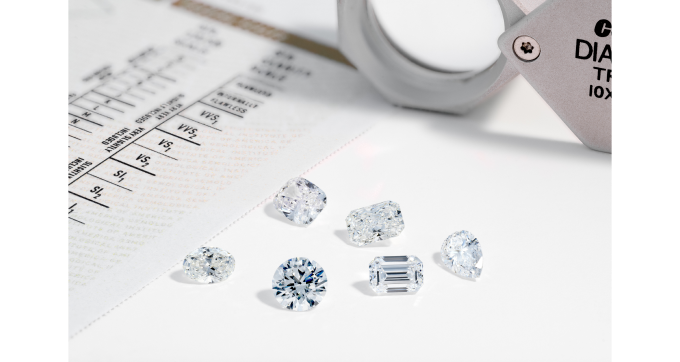Who doesn’t love a gorge little rectangular chonk of icy goodness? Emerald and radiant cut diamonds both very much deliver on the gotta love it front, but for oh-so different reasons. In fact, outside of their glittery geometry, the two couldn't be more different.
Whether you’re looking for that old Hollywood eleganza or more into the high-key sparkle realness, there is a rectangular rock with your name on it. So just what is the difference? Let’s get into it.
Same Difference
Emeralds and radiants always get compared, and it’s easy to see why. On the surface, they’re both gorge elongated little rectangles, unless, of course, they’re square. That’s right, both of these rocks come in varying length-to-width ratios, but the similarities don’t stop there.
Both of these shapes are beveled lil beauties and are easily recognizable by these cut corners. They also just so happen to carry more weight below the girdle. Meaning they both have a slightly smaller top-down appearance compared to a round brilliant. That, however, is about where the similarities end.
Sisters Not Twins
With all that in common, it’s easy to see why the two get compared so often. But their differences set them apart in a big way. While they may look similar on the outside (with your eyes closed, maybe), the differences shine big in the cut department. While both are gorge with that high key finger appeal, their majorly different facets create two separate styles of sparkle.
Emeralds
Emeralds bring it with the old-world glamour that was just made for a vintage aesthetic. It screams old Hollywood. That kind of elegance doesn't go out of style. It’s called a classic for a reason, and we live for a modern set Emerald. They simply do no wrong.
Emeralds are a step-cut stone, meaning they have long rectangular facts that meet at the pavilion–i.e., they go straight down that center line. These facets give off bright flashes of light rather than sparkly fire. Emeralds in all their glory have a clear glass-like appearance that is largely responsible for their boujee elegance. These glassy vibes, combined with their larger table, act as a window into the center of the stone.
Gorge? Yes. It also means you can see right through, so you never want to skimp on clarity when it comes to Emerald diamonds. Always go VS2 or higher since (unline brilliants) Emeralds aren’t hiding anything behind sparkle. While not being able to hide inclusions might seem like a scrilla-saving bummer, fear not, finesse fans. You can find a gorge Emerald with a J, or I color diamond that will appear colorless since the color isn’t retained by the sparkle.
Radiants
Radiants are sparkly. Like super sparkly. With 70 brilliant style triangular facets, they’re just about as shiny as they come. These tiny shiny facets produce a shattered glass effect that's wonderful for hiding inclusions but not so much for color.
Because of their deep cut combined with all those facets, the light return on a radiant is out of this world. It’s also going to return all that color. While you can probably find an eye-clean diamond with a lower clarity grade, you’re going to go with G, H, or higher when it comes to color. What about crushed ice radiants, you say? Some radiants give flashes of sparkle similar to a round brilliant. Others have tons of tiny sparkles, aka pinfire sparkles. These ones have the look of, you guessed it, crushed ice sparkling in the sunshine.
Which you choose has more to do with personal preference than anything else. If you’re into contrast, brilliants might be more your bag, but look out for bowties. Crushed ice, on the other hand, has that dripping in glitter vibe that some people absolutely love. Just get a look at these rocks on the move (aka a 360 preview) to catch a vibe check and find your perfect radiant.
Low Key Glamour
Emerald diamonds are super versatile. Because of their clean lines and flashy sparkle, they look straight elevated and snatched in both modern and vintage settings.
While that hall of mirrors needs no help drawing people in, many enjoy the combo that comes with setting that step-cut eleganza with a sparkly pavé. That or drenching it in tiny diamonds and going all the way with a halo. If you’re more into the classic, The Liv is giving everything we love about Emeralds with some shoulders for the assist.
High Key Sparkle
You gotta love brilliant rock like the radiant for all its versatility. Whether you're going clean and simple or want to be high-key dripping in diamonds, a radiant can handle whatever you throw at it.
All that sparkle hardly needs any help, and you can hardly go wrong setting on in a clean, classic solitaire… On the other hand, if you want to size up your sparkle–radiants do have a smaller top-down appearance after all–you can’t go wrong with a halo.
Seriously, can we talk about the next level gorgosity that is The Sofia set with a stunning 2ct radiant? We’re beyond gooped.
Ready To Cut Some Corners?
We love a rectangular moment. Whether you go for the sparkle city magic of a radiant or the clean sophistication of an Emerald, we totally stan. What can we say? They’re both gorge. When it comes to Emerald and radiant, nothing really compares to the clarity and step-cut realness of an Emerald or that kitchen sink crushed ice sparkle that is absolutely radiant.
VVS1 is like the Mary Poppins of diamond clarity. As in "practically perfect in every way." And while that might be an excellent quality in a magical nanny, it may be more than you bargained for in a diamond.
VVS1 diamonds can be absolutely gorge, but they can also be absurdly expensive. "But better is better!" they shout from the rooftops! And while that might be true when it comes to things like diamond cut, it's not a hard and fast rule of clarity.
Here's the deal, VVS1 diamonds are exceptional, obvi, but a clarity rating isn't everything. So let us give you the breakdown of what it means, what it costs, and what you can spend your money on instead.
VVS What?
VVS1 means very, very small inclusions. As in, the tiny imperfections in this diamond are so small you can’t even see them with a standard jeweler’s loupe. That’s 10x magnification!
So, in other words. VVS1 diamonds are super eye-clean, so much so that you’ll never see inclusions with the naked eye. It would take a trained professional using a hella powerful microscope to spot a single blemish in these babies.
Being so close to perfect clarity means they come with a price tag to match. While there are still two steps up from here, the clarity scale VVS1 is as high as it makes sense to go. Otherwise, you’re just spending to spend, and we can think of better places to put your money, like carat weight.
Practically vs. Perfect
Perfection is rare, especially when it comes to diamonds. So finding a Flawless (FL) diamond is kind of like finding a unicorn. Ok, so slightly less rare since they’re not mythical, but you get the point. Experts say finding a flawless diamond is nearly impossible.
Internally flawless diamonds (IF) are a little more common, however. IF diamonds have tiny inclusions and flaws, you guessed it, internally, but the exterior is perfection. Because it's so rare to find these two grades, they are majorly expensive. But, big surprise, they aren't really worth the extra dinero.
Because it's so very eye-clean, you're much better off going with a VVS1 over a flawless or internally flawless diamond. It's still nearly perfect, but it'll save you the big bucks–yes, it's still v. pricy–and you won't be able to tell the difference anyway. No one will. Unless your friends keep a high-powered microscope in their purse, then we can't help you.
Check out this side by side. Can you tell which is IF and which is VVS1? They’re both stunning. And while the difference between the two may only be a few hundred dollars in this particular example, those dollars add up, especially when you factor in the rarity. You’ll have a much harder time finding the IF diamond of your dreams than you will a VVS1.
Eye Clean, You Clean
Ok, real quick, what even is eye-clean? A diamond with no visual imperfections to the unaided eye, aka no magnification, is considered eye-clean. So a diamond being considered eye-clean has less to do with whether or not a diamond has inclusions and more to do with where they are and if you can see them. So a diamond that has a VVS1 or higher grade is guaranteed eye-clean. But that doesn’t mean you can’t find an eye-clean diamond with a lower clarity grade that will save you a bunch of money.
VS1 diamonds and sometimes even SL1 diamonds can be eye-clean. It's just a matter of talking to a jeweler and looking for yourself. It's yet another reason why cut is oh so important as it can hide a multitude of inclusions and blemishes, but we digress.
This 1.01ct VVS1 round diamond is gorge, but so’s this 1ct VS1 round diamond, and it’ll save you $3k.
Did We Mention It's Pricy?
VVS1 diamonds are nearly perfect, and they come with a price tag to match. We get it, they’re rare and stunning, so it makes sense. But there’s a common misconception that you should buy a diamond that is as close to perfect as possible because it will be a good investment.
To put it plainly, diamonds are never a good investment. Buy them because they mean something to you and your partner, because they symbolize your everlasting love, and most importantly because they are shiny. Ok, maybe not most importantly, but it is a big bonus.
The thing is, if you’re looking to save money, clarity is one of those places where you can do it without losing quality. Remember that whole eye-clean thing? Yeah, that. When you consider you can get a diamond that’s just as sparkly and gorge for thousands less, a higer clarity just seems like a weird flex.
But hey, if you've got it, flaunt it. If you don't want to settle for any less than perfection, we've got you covered. And if you would rather spend your money elsewhere, we've got your back there too.
Closely Related
So here's the deal, if you want an eye-clean diamond that still has a high clarity grade, you cannot go wrong with a VVS2. While it has slightly more inclusions than a VVS1, you'd be hard-pressed to tell the difference even with a jewelry loupe.
If we also consider the magic that is a good cut, you can slide on down to a VS1 and still have a killer eye-clean rock on your hands. Getting something that's close to perfect is expensive. But getting something that looks close to perfect can save you a bundle while giving you pretty much the same result.
Take a look at these princess cuts.
They've got the same cut and color and are nearly the same carat weight. The Difference? One is a VVS1 and has a price tag of $5,636. The other is a VS1 and costs about 2 grand less… It’s also a little bigger.
Which is better? Well, that's really up to you. The point is you can still get a beautiful eye-clean diamond with a VS1, but you'll save so so much money. But hey, if you don't want to save money, that's ok too. We are a business. After all, we're not complaining.
A Scientifically Perfect Solution
Still want a super high clarity grade without the price tag of perfection? How about a lab-grown diamond?
If you didn't know, lab diamonds are identical to natural diamonds, but they're also more sustainable, eco-friendly, and ethically sourced. Still not convinced? On average, lab diamonds cost about half as much as the natural alternative, making perfection a lot closer to your price range.
Seriously, peep these two VVS1 diamonds.
They’re both 1.1 carats, both have excellent or ideal cuts. In this case, the only difference is that the lab diamond has a slightly better color grade. Oh, and it costs $10,000 less than the natural diamond.
Whether you choose a lab diamond or a natural one, you're going to go home with the same gorgeous sparkle. If you're looking at the lab tho, you might also go home with a much bigger rock, and we don't see a lot of complaints in that department. How much bigger? Well, this VVS1 lab-grown diamond is 3.05ct, and it still costs less than the 1.1ct natural diamond pictured above.
Slice and Dice
As much as we love a flawless diamond–it is a magical thing to behold–there's one factor that remains supreme above all else. Cut. See, a VVS1 or even a flawless diamond with a bad cut is, well, just bad. The cut has everything to do with brilliance, sparkle, and truly everything that makes us fall in love with diamonds.
A well-cut diamond can hide internal flaws and blemishes, making it shine just as bright as one with no flaws, to begin with. A good cut is everything. And it's not just an improvement in visible clarity; it can even brighten lower color grades.
That's why it's so important to consider cut when you're taking a look at any diamond, no matter the clarity grade. It's also the reason that a VS1 and, in some cases, even an SL1 can shine just as bright as any other stone. So whether you go with a high clarity like a VVS1 or save a pretty penny with a VS1, take a moment to consider the cut. It makes a world of difference.
VVS1 and Done
Check it out. Diamonds have range. If you still want a VVS1 diamond, then you do, you boo. We'd never try to stop you. But in the event you want to save some money to spend on, say, a bigger diamond – peep the clarity scale.
And if it's absolute (near) perfection with a petite price tag you're after, why not go lab-grown? It'll save you a boatload of bills so you can spend that money where it matters on a big fat diamond.






